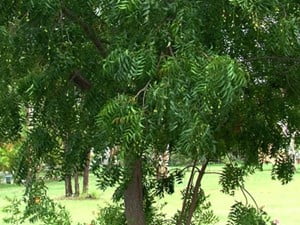Environment & Ecology
In News: Neem trees has been identified as twig blight and dieback disease in Telangana.
Neem:

- Neem is a member of the mahogany family, Meliaceae
- Neem trees are attractive broad-leaved evergreens that can grow up to 30 m tall and 2.5 m in girth.
- The roots penetrate the soil deeply
- When injured, they produce suckers – This suckering tends to be especially prolific in dry localities.
- It is grown from the southern tip of Kerala to the Himalayan hills, in tropical to subtropical regions, in semiarid to wet tropical regions, and from sea level to about 700 m elevation.
- Neem trees are strong can take considerable abuse.
- They can easily withstands pollarding (repeated lopping at heights above about 1.5 m)
- Neem shows antibacterial, antifungal, and other versatile properties
- But neem trees are sometimes hit by insect and fundal infestation
Dieback disease:
- The dieback disease affects leaves, twigs and the inflorescence of neem trees of all ages
- It causes almost 100% loss of fruit production in severely infected trees
- The dieback disease is mainly caused by the fungi Phomopsis azadirachtae.
- The dieback disease was first reported in the country during the 1990s near Dehradun in Uttarakhand, while it was first noticed in Telangana in 2019.
- The appearance of symptoms starts with the onset of the rainy season and becomes progressively severe in the later part of the rainy season and early winter.
Control measures:
- The twigs affected by the disease should be cut and a blend of fungicide and insecticide can be sprayed after their removal.
- Alternatively, a pit should be dug around an affected tree, and water mixed with fungicide and an insecticide should be poured into it.
- However, the efforts to treat the affected trees should be taken up as a cluster either in a village or in a residential locality in urban areas as the fungus is airborne.
- Even if treatment is carried out for one tree, the fungus spores from a nearby tree can affect the treated plant again.
- Spraying chemicals on big trees is a difficult task as it may hit insects like butterflies and also pollute water bodies nearby.
Source: The hindu











